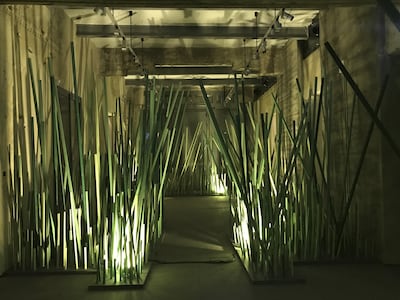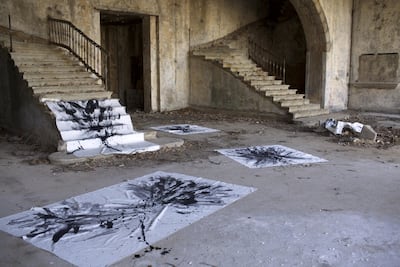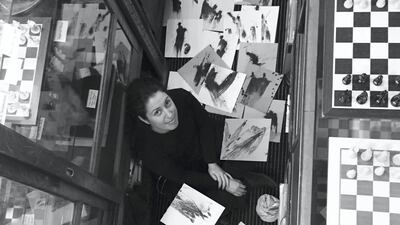Inside the old Barakat Building, where walls are still stained black by fire and riddled with bullet holes, a forest is growing. Exactly 17,000 sticks, each painted a verdant green, seem to sprout from the floors.
Part of an installation by Lebanese artist Zena El Khalil, each represents one of the 17,000 people estimated to have disappeared during Lebanon’s 1975-1990 civil war.
They are also a tribute to the location. The Barakat building is on the former Green Line between east and west Beirut, so nicknamed because of the plants and trees that grew up along the stretch of road, which was inaccessible for more than a decade.
“It was called the Green Line because it was literally green. Where no humans are, nature prevails. So it’s an homage to mother nature and to those who are still missing,” says El Khalil.

The building, which dates back to 1924, was a notorious snipers’ nest during the war. When fighting stopped in the early 1990s, it was a shell – but a passionate civil society campaign to save it from destruction resulted in its expropriation by the municipality.
A decade on, it is opening to the public for the first time as Beit Beirut, Lebanon’s first museum of memory, after an US$18 million (Dh66m) restoration.
Although the museum is not yet formally open – it has neither a director nor a public programme – El Khalil’s temporary solo exhibition marks the first time the public are able to visit the space.
Haunting and eerie, the building has been renovated in a way that preserves much of the damage done during the war, including the snipers’ sandbag barricades on the first floor.
El Khalil felt that Beit Beirut was the perfect space to host her exhibition, which focuses on healing, forgiveness, compassion and love.
The artist is showing a new series of work that comes after a five-year hiatus from exhibiting, during which she changed the style and focus of her work.
She spent this time performing healing ceremonies in places marred by violence and tragedy, beginning with her family home in Hasbaya, a village in south Lebanon.
“Hasbaya was occupied by the Israeli army for over 20 years and our home was turned into a military prison and interrogation centre by the Israeli army,” she admits. “So our home became a space where people were interrogated, tortured and held without reason.”
The day the forces withdrew, she went home for the first time. But it took her more than a decade to begin to process what had happened to it. As a way to cleanse it of violence, she decided to perform a healing ritual, chanting words of peace and lighting a symbolic cleansing fire.

“As the years went by, I started doing these healing ceremonies in other spaces,” she explains. “The premise of all of this work began with this question I asked myself: is it possible to create an object that could somehow heal the land?”
El Khalil began painting what she calls mantras, small paintings each bearing a single word: compassion, love or forgiveness. She leaves one of these at every site she visits, sometimes pinned to a wall, sometimes buried or hidden.
In Sacred Catastrophe: Healing Lebanon, curated by Janine Maamari and Beatrice Merz, she showcases the paintings, photography, videos, sculpture and installations that grew out of this private ritual.
A series of black-and-white abstract paintings resembling sunbursts or blossoms were made using ashes from the fires she burned at the different sites she visited.
“To do the paintings I use cloth, mostly kuffiyehs, to paint with. I dip them in the ink and then I strike the canvas, so what you get is an imprint,” she says.
“I’m connecting to the energetic source of that land, so each painting is different … They look black and grey but if you were to put the substance under a microscope it would show you that each one’s molecular arrangements are unique and specific to that space.”
Alongside the paintings, she is exhibiting delicate handmade ceramic tiles that form a dialogue with the remaining original floor tiles inside the Barakat building. Each one is imprinted with one of the three words she uses in her mantras.
The enormous installation piece for the disappeared, which occupies the second and third floor of the building, is accompanied by a sound piece consisting of a poem the artist wrote, read in English and Arabic against a backdrop of sound recorded in her home in Hasbaya and the notorious Khiam Detention Centre, a prison camp used by the Israelis until the year 2000.
The installation was partially installed by a delegation of the families of those who disappeared.
“The wives who had husbands that never came home, a lot of them are in their late fifties and older now. It’s for them. It’s an opportunity to communicate and say that we do care, as a community,” says El Khalil.
“It’s a memorial commemorating the disappeared but it’s important to be clear that it’s not resolved yet. We don’t know where they are. So it’s not commemorating their deaths, because we don’t know that. It’s a reminder.”
The overall aim of the exhibition, which opened on Monday and runs for 40 days – a number symbolic for transformation according to El Khalil – is to provide a space and context for public discussions about memory, trauma, reconciliation and peace.
_______________
Read more:
Lebanon's movement to remember
Art exhibitions in the UAE: what to see now the new season is here
Acclaimed Lebanese director hauled before military tribunal
_______________
El Khalil is leading daily on-site healing ceremonies, during which she encourages people to focus on forgiving themselves and others, and a mandala painting station allows people to sit and paint the words love, compassion and forgiveness.
A comprehensive programme of workshops, conferences, performance, concerts and debates offers everything from healing meditation to lessons on the power of language.
The artist hopes that the exhibition will help begin a long-overdue process of coming to terms with Lebanon’s violent past and fractured society.
“The war ended and the next day everyone was back at work. There was no reconciliation, there was no healing, and then 20 years went by. I don’t see people addressing it publicly because we don’t talk about our pain in public. We don’t talk about our pain period,” she says.
“We talk about if people are rude to us on the street. We talk about if people are ripping us off. We talk about corruption in politics. But we don’t talk about how it’s hurting us, on a personal level …
“If we can find the right words to communicate then we can start building on that.”
Her optimism may seem a little naïve in the face of Lebanon’s tragic history and daunting problems but, in fact, her bottom-up approach is perhaps the only option in a country where a top-down amnesty led to decades of political amnesia and simmering sectarian tensions.
“I’m not so concerned with changing the world because to change the world you need to change yourself first,” she says. “We have to change collectively. These exercises all help with the idea of cultivating inner peace, self-love, self-empathy, because these are things we don’t talk about in this part of the world.”
Sacred Catastrophe: Healing Lebanon continues at Beit Beirut until October 27

